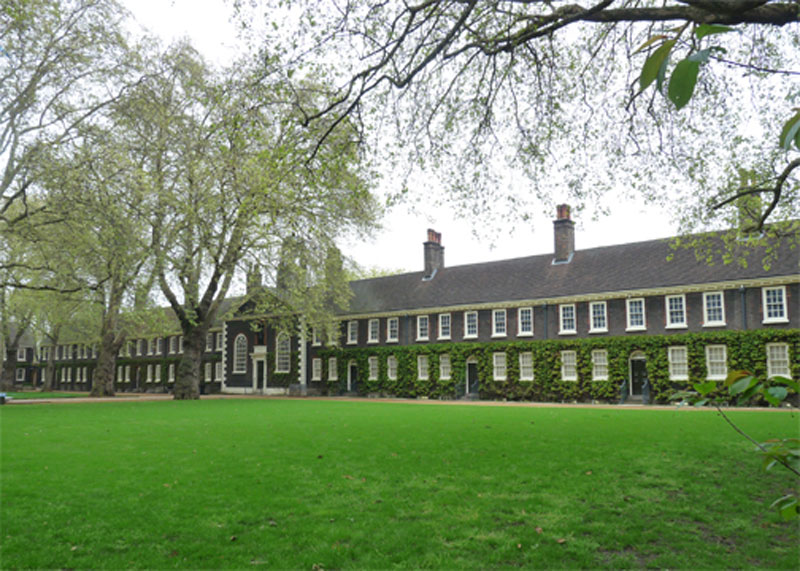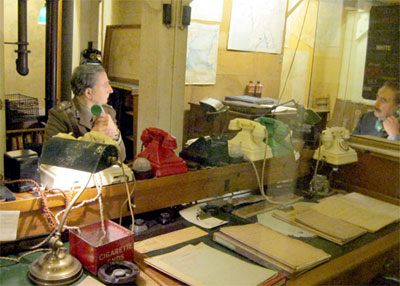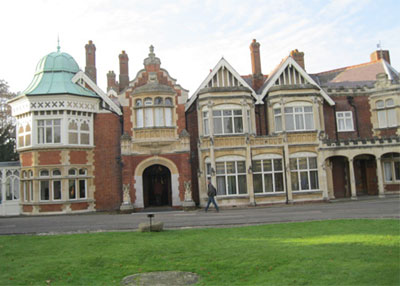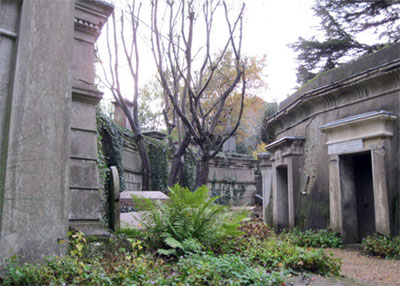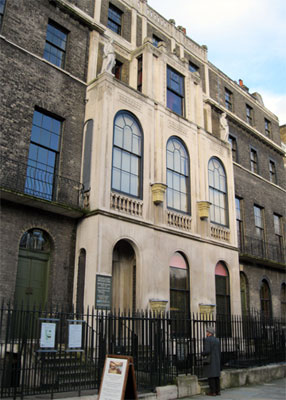Alternative London – finding treasures beyond the typical city sites
This article appears on page 20 of the July 2015 issue.
Many of the great cities of the world warrant multiple visits to discover all of their hidden gems. London is no exception.
Despite visiting often, I still find exciting things to see and do. On a one-week visit in November 2014, I managed to see several museums and other sights that have been on my “to do” list for a long time.
All these venues are an easy 15- to 20-minute walk from nearby Underground stations. Bletchley is about an hour’s journey by train from Euston Station, then a 10-minute walk.
The sites
Leighton House Museum (12 Holland Park Rd.; rbkc.gov.uk/subsites/museums.aspx) — nearest Underground station: High Street Kensington (Circle and District lines).
Cost: Adult, £7 ($11); senior or student, £5 ($8), and child 5 and under, free. Recommend booking in advance.
Hours: Open 10 a.m.-5:30 p.m. daily except Tuesdays.
The Leighton House Museum, located in the Holland Park district of Kensington, former home of artist Frederic Leighton. It includes his spectacular studio, the beautifully tiled Arab Hall and a large collection of paintings and sculpture.
I booked my 10 a.m. ticket online.
The building’s plain brick Victorian exterior gives no clue as to the treasures in store inside. At reception, I was given a complimentary catalog of the art collection and invited to take a self-conducted tour through the house, moving from the dimly lit dining room and into the spectacular Arab Hall, where it felt like I had been transported to the Alhambra! As I moved up the broad, wooden staircase to the next floor, I was surrounded by more spectacular paintings.
Every inch of wall was covered in art. There were paintings by Edward Burne-Jones and Dante Gabriel Rosetti, among others, and, of course, by Leighton, himself.
Off Leighton’s huge studio, a separate gallery displayed “The Roses of Heliogabalus,” a spectacular painting by Lawrence Alma-Tadema that was part of the exhibition titled “A Victorian Obsession.”
The rooms were quite dim to protect the art. Having a small flashlight to read the catalog as you go from one painting to another would be really helpful.
Allow at least two hours to get through the house. Photography is not allowed.
Sir John Soane’s Museum (13 Lincoln’s Inn Fields; www.soane.org) — nearest Underground station: Holborn (Piccadilly and Central lines).
Cost: Free, but please make a donation!
Hours: 10 a.m.-5 p.m. Tuesday-Saturday. Last entry at 4:30.
If you have an interest in art, archaeology and architecture, this fascinating museum is for you. The “Oxford Dictionary of Architecture” calls Sir John Soane’s Museum “one of the most complex, intricate, and ingenious series of interiors ever conceived.”
Sir John Soane, born in 1753, was an architect who rose in his profession to design numerous public and private buildings, the most famous being the Bank of England.
He designed 13 Lincoln’s Inn Fields as his home and a setting for his antiquities and works of art.
You have never seen so much “stuff” — stone carvings, casts, sculptures, friezes, pots, urns, statues, paintings and drawings and classical and medieval antiques — all piled, one on top of the other, throughout the houses that he has knocked together to form this amazing museum.
There is an art gallery with special, hinged walls that open out to display paintings on both sides. There is even a giant sarcophagus in the basement!
You have to shimmy and slide through narrow passages and doorways to maneuver yourself through this amazing collection. I couldn’t help wondering who does the dusting.
You may be dazzled (literally) as you walk into the Yellow Drawing Room, but, trust me, even more wondrous sights are in store for you. Not to be missed! (Photography is not allowed.)
Walking tours
London Walks (phone +44 [020] 7624 3978, www.walks.com) has to be one of the best bargains in town. (£10, or $16, per adult, £8 for senior or student). Led by trained guides, the walks cover a wide variety of areas, from the Tower of London to Jack the Ripper haunts.
They are available throughout the day, with starting times from 10:30 a.m. to 7:30 p.m. for evening walks. Walks last about two hours and vary by the day of the week and time of year.
What I love about these walks is you do not have to book in advance. Just select the walk you want from their website, check the meeting point and be there at the appointed time. You don’t pay until you get there.
Instructions for meet-up are simple and explicit: “Outside Westminster Underground Exit #4.” Guides tend to show up at the last minute and then spend the next 20 collecting money, which gives latecomers time to arrive.
On this occasion I took the “Old Westminster by Gaslight” tour. While I waited outside Westminster Underground station, I grabbed a cup of hot chocolate from a nearby vendor and watched people as they came up the steps from the Underground.
As they emerged from the station, they were met with a view of Big Ben towering above them. As people caught sight of the illuminated tower disappearing into the night sky, they usually emitted a loud “Wow!” or “Awesome!” Having the clock chime its famous bells as they emerged was an added bonus!
When our guide, Fedora, arrived, she started to collect our money and went into her banter. She was absolutely delightful, with a great sense of humor and lots of jokes and stories to share. She was a qualified Blue Badge Guide, and it was interesting to hear of all the exams they have to pass in order to gain this august distinction.
Our walk started with our crossing the Westminster Bridge, offering spectacular views of the Houses of Parliament and Big Ben on one side and the London Eye, a huge circle of glowing blue, on the other. From there we wandered down side streets and past the Houses of Parliament and Westminster Abbey, all floodlit, with hardly anyone around.
As we wandered from one street to the next, Fedora pointed out buildings along the way. Who knew England had a Supreme Court? And did you know there was a Houses of Parliament shop where you can pick up your House of Commons Christmas mug or House of Commons diary?
As we walked deeper into the pristine streets lined with beautiful brick houses, we were delighted to see that the streetlights were, indeed, gas lit!
This was a delightful and easy walk, and we got lots of good information for revisiting the area in daylight plus tips for visiting the House of Commons or Lords.
And there’s more! London Walks also offers walks outside London. They have day trips to Bath, Stonehenge and Cambridge at a fraction (£43-£55) of what more conventional tours cost — and they’re more fun!
The more unusual
Highgate Cemetery (Swain’s Lane; highgatecemetery.org) — nearest Underground station: Archway (Northern line), then walk or take bus 143, 210 or 271.
Cost: Adult, £12, or child (8-17), £6. I recommend booking in advance.
Hours: They vary; check website.
For a completely different experience in London, a visit to Highgate Cemetery is a must. Located in North London, it is easily accessible from Archway Underground station. (The website has a map and directions.)
It is quite a schlep up Highgate Hill, and it will take you about 30 minutes to walk. (OK, I know I said most walks from the Underground stations were 15 to 20 minutes; this one is the exception.) You can also take a bus up the hill, then walk through Waterlow Park to the cemetery.
The cemetery is divided into East and West sections, and the tour ticket gains you access to both parts. November was a perfect time to visit; it was cold and damp, so really “good” cemetery-visiting weather.
From the Gothic gatehouse, the tour leader took us up steps and along the meandering paths between graves that were seemingly scattered higgledy-piggledy among the overgrowth. Moss-covered trees and bushes slithered over the hurly-burly of tottering obelisks, crumbling mausoleums and sentinel angels.
For those who wanted a more prominent resting place, a vault on the Egyptian Avenue or Circle of Lebanon, accessed through a decorative portal flanked by Egyptian columns, could be chosen.
A musty columbarium, accessed via a dark, dank passageway, was definitely the spookiest part of the cemetery and not recommended for the faint of heart. Our guide regaled us with tales of the people buried there, who seemed to be mostly obscure literary figures or artists none of us had ever heard of. The few names I did recognize were those of the Charles Dickens family and the writer Radclyffe Hall.
Across the road in the East Cemetery, Karl Marx is still getting flowers on his grave.
Code breaking
Bletchley Park (The Mansion, Bletchley Park, Sherwood Dr., Bletchley, Milton Keynes; bletchley park.org.uk) — nearest Underground stations: Euston on the Northern or Victoria lines or Euston Square on the Circle and Metropolitan lines, then walk to the Euston railway station to take the train to Bletchley; return train fare from Euston to Bletchley is £14. Travel time, approximately one hour.
Cost: Adult, £16.75; senior, £14.75, and child under 12, free (12-16, £10).
Hours: 9:30 a.m.-5 p.m. March 1-Oct. 31 and 9:30-4 Nov. 1-Feb. 28.
Bletchley Park was the site of the British Government Code and Cypher School, which monitored and broke secret enemy codes during WWII. It is most famous for breaking the German Enigma and Lorenz ciphers. Today it is a museum and open to visitors.
When you purchase your train ticket for Bletchley Park at the Euston Mainline Station ticket counter, ask what the train destination will be. Knowing mine was Northampton made it easier to locate it (and its corresponding platform number) on the rather extensive departures information board hanging over the platform entrances.
The trains are clean and comfortable, with electronic signs and announcements for upcoming stations. Even for the inexperienced traveler, it’s well-nigh impossible to make a mistake or get lost.
On exiting Bletchley Station, Bletchley Park is a 10-minute walk directly across the road. Follow the signs. As you approach the gates, the entrance is through the visitor center on the right.
It’s best to allow a full day for your visit.
Bletchley Park has come into the news again with the release of the movie “The Imitation Game,” which tells the story of Alan Turing’s breaking of the Enigma code during WWII. Others may be familiar with Bletchley Park from the British ITV series “The Bletchley Circle,” which was a mystery series about four women who used to work as code breakers in Bletchley.
Initially, I planned to spend only an hour or two there, but once I started to wander through the museum, watching the many films about the war and trying to figure out radio messages in Morse code, I was hooked. And I hadn’t even made it out of the visitor center area!
A poignant experience was standing back to watch and listen to the British visitors, especially the older ones, as they discussed with each other the war and their personal experiences as they viewed the displays.
There was a replica of The Bombe, the machine Turing invented to break the codes. A tour guide explained, in layman’s terms, the function of the machine and how it worked so we could all understand.
In the front of the machine, rows and rows of wheels clattered and whined as they spun incessantly, making thousands of calculations, while, at the back, miles of cables connected the circuits.
Once out of the visitor center, you can visit the museum and the various other huts scattered around the grounds. In front looms the red-brick house, the original mansion on the property, with its peculiar green-colored cupola at one end.
Inside are the offices of Commander Alistair Denniston, head of the Code and Cypher School. Also located there are the bar and many of the props, including The Bombe, that were used in the movie.
Tours of the grounds run from the mansion and are well worth taking, as they give you additional information about what went on there. It’s hard to believe that at the end of the war, 9,000 people were working there.
It was a spellbinding glimpse into the precomputer age and how the work done at Bletchley changed the course of history.
Winston and the war
The Churchill War Rooms (Clive Steps, King Charles St., London; iwm.org.uk) — nearest Underground station: Westminster (Circle, District and Jubilee lines).
Cost: Adult, £18; senior, £14, and child (5-15), £9.
Hours: Open daily 9:30 a.m.-
6 p.m.; last admission, 5 p.m.
The Churchill War Rooms is an underground bunker that housed the British command center during WWII. Today it also includes the Winston Churchill Museum.
Although conveniently located right smack in the middle of Whitehall, many people bypass this fantastic museum as they rush from the Horse Guards to Downing Street to Big Ben.
Part of the Imperial War Museums group, it’s actually two museums rolled into one: the Cabinet War Rooms and the Churchill Museum. Entry is through a rather innocuous glass door with a black canopy to the side of Clive Steps.
I recommend you get the audio guide (included in the ticket price).
A short flight of steps leads down into the “bunker.” From there, a self-guided walk will take you down meandering corridors that allow you to see into various rooms — the War Cabinet Room, the Map Room, the Chief of Staff Conference room, the Telephone Exchange and the staff living quarters. Realistic mannequins give the impression that the war is still in progress and everyone is busy at work.
Pay attention to the clocks. Notice anything peculiar about them?
You can also see Churchill’s living quarters as well as his dining room and kitchen.
While photography is allowed, be aware that most of these rooms are behind glass walls. Set your camera accordingly.
One of the most moving parts, for me, was listening to the reading of an officer’s journal written in 1940, when an imminent attack from Germany was a real possibility and there was really nothing to be done but wait.
Construction of the rooms started in 1938 and they went into use in 1939. Despite the fact that they were supposed to protect the cabinet from bombing raids, the bunker is, in fact, not very deep underground. A concrete barrier, up to 3 meters thick known as “the Slab” was poured and shorn up with wooden columns.
Fortunately, the site remained secret from the Germans throughout the war and never suffered a direct hit.
Adjacent is the Churchill Museum, with extensive coverage of his life and times on film and audio clips plus other paraphernalia, including his nightshirt and an old cigar. There was so much information, I found the place a little overwhelming, but Churchill aficionados will certainly enjoy it.
The lighting was very muted, which made it difficult to read many of the display labels, so, again, a small flashlight would come in handy.
There is an extensive gift shop and a café.
Allow at least two hours for a visit (more if you also want to linger in the Churchill Museum).
A step back in time
Dennis Severs’ House (18 Folgate St.; www.dennissevers house.co.uk) — nearest Underground station: Liverpool Street (Circle, Metropolitan, Central and Hammersmith & City lines).
Cost: £10-£60 ($15-$92), depending on tour and time selected; see website for details. It is imperative to book well in advance; a wait list is available.
Dennis Severs’ House is “both a breathtaking and an intimate portrait of the lives of a family of Huguenot silk-weavers from 1724 to the dawn of the 20th Century,” as described on its website.
If you have ever wanted to time travel, this is your opportunity. To step into Dennis Severs’ house is to step into another world, another era.
Dennis Severs was born in Escondido, California, but obviously felt he was born into the wrong century. He moved to London in 1979 and bought an 18th-century house in Spitalfields, in East London, where he proceeded to renovate each room into a different historical style from the 18th and 19th centuries.
He installed the imaginary Jervis family, French Huguenots in the silk-weaving business. As you move into a room, you sense that someone has just left it — there’s an unfinished cup of tea on a table, the makings of unmixed bread dough with an egg ready to be added in.
Outside, you can hear the faint clip-clop of horses on cobblestones, and an unanswered front doorbell clangs incessantly. (You want to yell out, “Can someone, please, get that?”)
Overhead, floorboards creak. Fires blaze and candles flicker. Another room, different smells. An upturned chair. Rumpled bedsheets — cast aside in haste?
Severs’ overactive imagination got him into trouble with his peers, who tended to sneer at him, as many of his tableaux were not “historically correct.” But it is this visual ambiguity that delights visitors.
You are allowed to freely wander around, snooping at letters and books left opened on tables, peering under beds and behind doors. From the moment you cross the threshold, you are invited to explore the rooms on each floor at your own pace, in silence.
The number of people allowed in for each tour is relatively small, so for much of the time you have many of the rooms to yourself. Docents are stationed on each floor in case you need guidance or have any questions.
Shortly before his death in 1999, at the age of 51, Dennis Severs bequeathed the house to the Spitalfields Trust.
Tours are infrequent and sell out quickly; it is imperative you book well in advance. You will never experience anything like this again. I guarantee it!
One last site
The Geffrye Museum of the Home (136 Kingsland Rd.; www.geffrye-museum.org.uk) — nearest Underground station: Old Street (Northern line.) Note: Check weekend station closings. Hoxton overground train may be more convenient.
Cost: Free for the museum; £3 ($5) to visit the restored almshouses, available only on certain days on a first-come, first-served basis.
Hours: 10 a.m.-5 p.m. Tuesday-Sunday and on bank-holiday Mondays.
The Geffrye lists itself as the “Museum of the Home” and displays 11 period rooms, illustrating how styles and tastes have changed over time. The rooms are arranged chronologically, starting at 1600 and ending at the end of the 20th century.
The museum actually occupies former almshouses, built in 1714 by the Ironmongers’ Company with money donated by Sir Robert Geffrye, a former Lord Mayor of London. The almshouses provided homes for up to 50 poor pensioners.
In the early 20th century, the almshouses were relocated and the London County Council planned to demolish the buildings. Fortunately, the council was petitioned to prevent the demolition, and the buildings were converted into a museum in 1914.
One of the almshouses has been restored, with most of its original woodwork intact. By modern standards, the homes were actually quite spacious and cozy.
There are lovely gardens in the back and an excellent café in the main building.
You will have noticed on your walk from the Underground that this is a very funky neighborhood with lots of little shops and galleries — well worth a browse around on your way back or on a later visit.
Helpful hints
November is a perfect time to visit London, as there are relatively few crowds and no lines anywhere. Airfares and accommodation rates are lower too.
Things change all the time, so it is imperative that you check the websites listed to confirm opening times and entry fees, where applicable.
The London Underground (the Tube) has been in a continuous state of meltdown for years, suffering numerous delays and closures, especially at weekends. Know your alternative bus routes, just in case. Despite this, it is usually the easiest and quickest way to get around. For the latest information, visit www.tfl.gov.uk.
I’d suggest getting an Oyster Card (do a Google search; the URL is a mile long!). The card allows you unlimited travel on buses, the Underground, overground trains and the Docklands Light Railway. Prices vary depending on the number of days you select and the travel zones to be covered. Travel Zones 1 and 2 are fine for most visitors. My 7-day, 2-zone card cost £37 ($56.50).
Accommodation — Not using Airbnb.com yet? Why not?!

